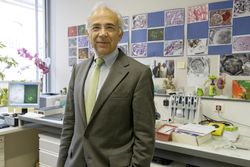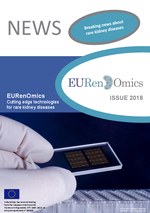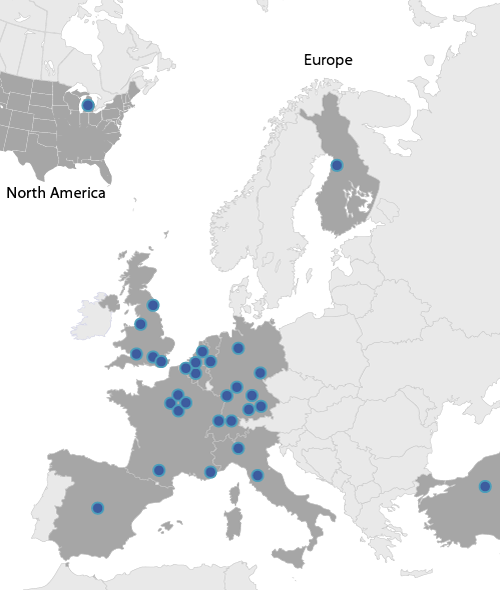INSERM UMRS 702 (Hôpital Tenon, Paris)
INSERM UMRS 702
Hôpital Tenon
Rue de la Chine 4
75020 Paris
France
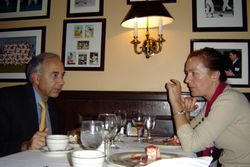
- Prof. Pierre Ronco and Dr. Hanna Debiec
Dr. Hanna Debiec
Research Director/Head MN Group
Phone: + 33 1 5601 6028
Fax: + 33 1 5601 6512![]() Contact
Contact
Project Staff
Dr. Claudia Seikrit
PostDoc
Phone: + 33 1 5601 6028
Fax: + 33 1 5601 6512![]() Contact
Contact
Philippe Fontanges
Engineer
Phone: + 33 1 5601 7158![]() Contact
Contact
Caroline Martin
Engineer
Phone: + 33 1 5601 8398![]() Contact
Contact
Chantal Jouanneau
Assistant Engineer
Phone: + 33 1 5601 7969
Fax: + 33 1 5601 6512![]() Contact
Contact
Marie-Christine Verpont
Assistant Engineer
Phone: + 33 1 5601 6514
Fax: + 33 1 5601 6512![]() Contact
Contact
Timothée Pelle
Assistant Engineer
Phone: + 33 1 5601 6028
Fax: + 33 1 5601 6512![]() Contact
Contact
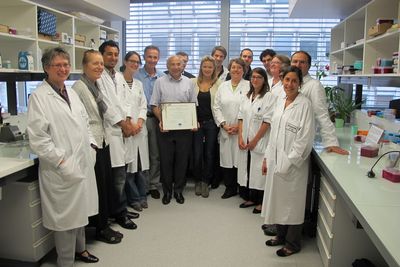
- The Team of INSERM UMR_S702 Paris with the "godfathers" of the Fondation pour la Recherche Médicale (FRM) institute, French actor Thierry Lhermitte (5th from left) and Belgian actress Virginie Efira (to the right of Prof. Ronco).
Institute Presentation
Pierre Ronco’s lab located at Tenon hospital, is a world leader in the field of membranous nephropathy (MN) with the identification of 2 of the 3 main target antigens and 2 strongly predisposing genes, and a founder of the European MN Consortium whose members are participants in WP3.
The lab is affiliated to both INSERM and University Pierre et Marie Curie, two prestigious institutions with several Nobel Prize awardees. Through these institutions, the lab has smooth access to a wealth of life and health science research units as well as to world-leader experts in mathematics, and to unique equipments such as the synchrotron Soleil which will be used in the current project.
The lab is composed of three research teams averaging a total of 45 basic and clinical investigators (5 full-time tenured INSERM researchers, 12 part-time academic researchers from the University, 12 full-time technicians, 10-15 doctoral students, post-doctoral fellows and visitors) closely connected to 2 renal divisions (60 beds including ICU) and to a clinical investigation centre for renal patients. It is fully equipped with up-to-date research facilities including next generation sequencer and cell sorter, biphotonic laser confocal and electron microscopes, proteomics platform and excellent animal facilities (5,000 mice). It has contributed to the creation of Federative Institute of Research 65 (Institut de Recherche en Santé) where more than 300 scientific personnel involved in various fields of basic and clinical research are employed, and of the National Reference Centers of Rare Hereditary Renal Diseases in Child- and Adulthood (MARHEA) and Primary Nephrotic Syndromes including membranous nephropathy.
The 2 leaders of the team on the MN project are:
Pierre Ronco, MD, PhD, is a clinical scientist with a 30-year experience in immunopathology of kidney diseases and in rare genetic diseases (including the description of HANAC and neprilysin deficiency). He received numerous awards including the prestigious Jean Hamburger award from the International Society of Nephrology (2007). He was the European editor to Kidney International, and chaired the scientific programme committees of 4 major congresses (ISN, ERA-EDTA). He was the president of the immediately past ERA-EDTA congress in Paris with more than 10,000 participants. He is currently serving as an advisor to the Nephrotic Syndrome Study Network (NEPTUNE, Univ. of Michigan and NIH) and has a seat in many national and international boards. He has extensive experience in running EU projects, mostly as a WP leader (EUNEFRON FP7-HEALTH-2007-A). He has also received an European Research Council advanced grant in 2012.
Hanna Debiec, PhD, was trained in biochemistry, cell biology, and physiology. She is the scientific director of Ronco’s immunopathology research team, and has made seminal discoveries on the pathogenesis of MN.



